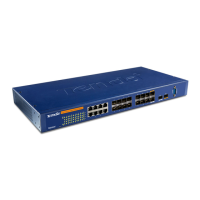24-Port Managed Gigabit Switch
2. IEEE 802.1p Priority
Priority tagging is a function defined by the IEEE 802.1p standard,
which provides a means of managing traffic on a network where
many different types of data may be transmitted simultaneously.
Network devices compliant with the IEEE 802.1p standard have the
ability to recognize the priority level of data packets. These devices
can also assign a priority label or tag to packets. Compliant devices
can also strip priority tags from packets. This priority tag determines
the packet's handling degree and determines the queue to which it
will be assigned.
Priority tag values range from 0 to 7 with 0 being assigned to the
lowest priority data and 7 assigned to the highest. The highest
priority tag 7 is generally only used for data associated with video or
audio applications sensitive to even slight delays. TEG3224T allows
you to further tailor how priority tagged data packets are handled on
your network. Using queues to manage priority tagged data allows
you to specify its relative priority to cater for the needs of your
network. There may be circumstances where it would be
advantageous to group two or more differently tagged packets into
the same queue. Generally, however, it is recommended that the
highest priority queue, Queue 4 (High), be reserved for data
packets with a priority value of 4. Packets that have not been given
any priority value are placed in Queue 1 (Low) and thus given the
lowest priority for delivery.
3. DSCP (Differentiated Services Code Point) Priority
In QoS, a modification of the type of service byte, six bits of this
byte are being reallocated for use as the DSCP field, where each
62

